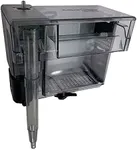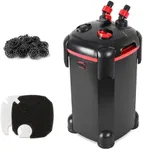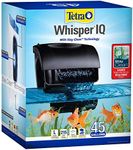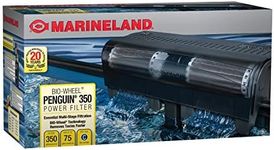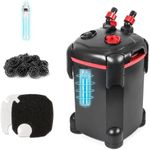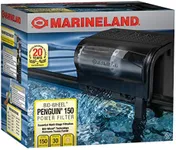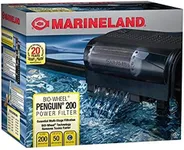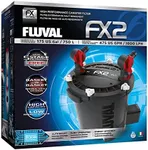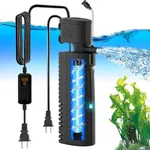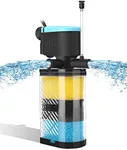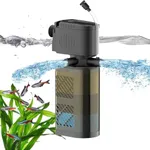Buying Guide for the Best Aquarium Filter System
Choosing the right aquarium filter system is crucial for maintaining a healthy and clean environment for your aquatic pets. A good filter system helps to remove waste, toxins, and debris from the water, ensuring that your fish and plants thrive. When selecting a filter system, it's important to consider the size of your aquarium, the type of fish and plants you have, and the specific needs of your aquatic ecosystem. Here are some key specifications to consider when choosing an aquarium filter system.Filter TypeThe filter type refers to the method by which the filter cleans the water. There are three main types: mechanical, biological, and chemical. Mechanical filters physically remove debris from the water, biological filters use beneficial bacteria to break down harmful substances, and chemical filters use activated carbon or other media to remove toxins. It's important to choose a filter that provides the right combination of these methods for your aquarium. For example, a heavily stocked tank may benefit from a filter that excels in biological filtration, while a tank with a lot of plants might need more mechanical filtration to remove plant debris.
Flow RateFlow rate is the amount of water that the filter can process in a given time, usually measured in gallons per hour (GPH). This is important because it determines how effectively the filter can clean the water. A higher flow rate means more water is being filtered, which is generally better for larger tanks. For small tanks (up to 20 gallons), a flow rate of 100-200 GPH is usually sufficient. Medium tanks (20-50 gallons) may need 200-400 GPH, and large tanks (over 50 gallons) often require 400 GPH or more. Choose a flow rate that matches the size of your tank and the needs of your fish.
Filter MediaFilter media are the materials used inside the filter to clean the water. Common types include sponges, ceramic rings, and activated carbon. Each type of media serves a different purpose: sponges provide mechanical filtration, ceramic rings offer biological filtration, and activated carbon provides chemical filtration. It's important to choose a filter that allows you to customize the media to suit your aquarium's needs. For example, if you have a lot of fish, you might want more biological media to handle the increased waste. If you have a planted tank, you might need more mechanical media to keep the water clear.
MaintenanceMaintenance refers to how easy it is to clean and replace the filter media. This is important because regular maintenance is necessary to keep the filter working effectively. Some filters are designed to be easy to open and clean, with media that can be quickly replaced. Others may require more effort and time to maintain. Consider how much time you are willing to spend on maintenance when choosing a filter. If you prefer a low-maintenance option, look for filters with easy-access compartments and reusable media.
Noise LevelNoise level is the amount of sound the filter makes while operating. This is important if you want a quiet environment, especially if the aquarium is in a living room or bedroom. Some filters are designed to be very quiet, while others may produce more noise. If noise is a concern for you, look for filters that are specifically marketed as quiet or have noise-dampening features. Reading user reviews can also give you an idea of how noisy a filter might be.
Size and CompatibilitySize and compatibility refer to the physical dimensions of the filter and how well it fits with your aquarium setup. This is important because the filter needs to fit comfortably in or on your tank without taking up too much space or interfering with other equipment. Measure your tank and check the filter's dimensions to ensure a good fit. Also, consider whether the filter is compatible with any other equipment you have, such as heaters or air pumps.

